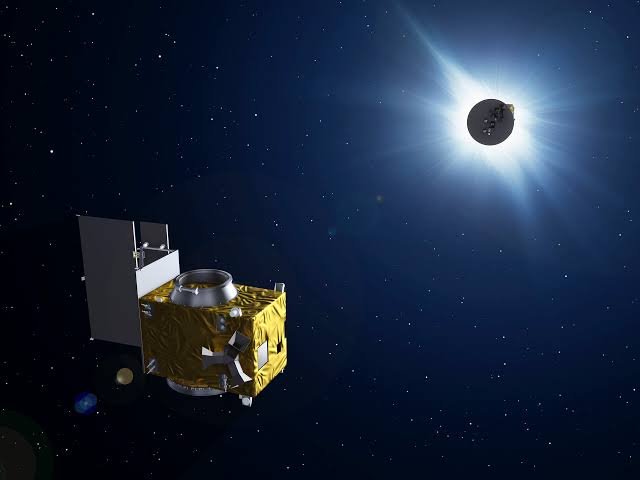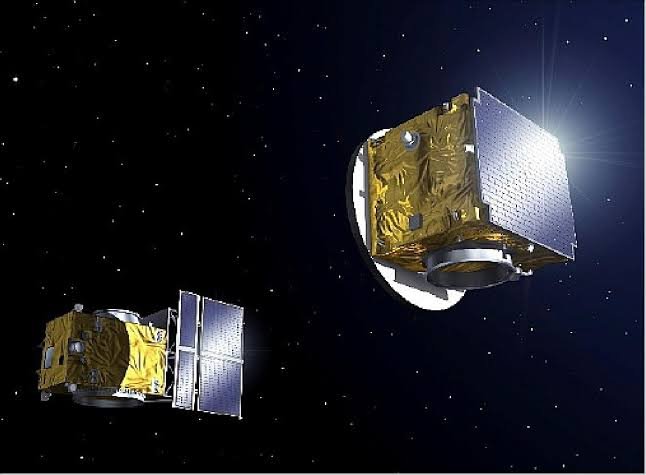Proba-3, a European Space Agency mission involving 14 nations and 40 companies, is set to launch from India. Learn why ISRO, not Europe, is spearheading this groundbreaking endeavor.
Introduction: Proba-3 Mission Overview
The Proba-3 mission is a unique and ambitious project by the European Space Agency (ESA). This international collaboration involves the participation of 14 countries, including Canada and 13 European nations, alongside 40 companies contributing cutting-edge technologies. It marks a significant milestone in solar science by utilizing two satellites to simulate an artificial solar eclipse in space.

The mission’s core objective is to study the Sun’s corona, a task that has remained elusive due to the Sun’s overwhelming brightness. The precision required for this endeavor places Proba-3 at the forefront of technological innovation. However, what makes this mission even more intriguing is its launch from India’s spaceport at Sriharikota, under the expertise of the Indian Space Research Organisation (ISRO).
Why is ESA choosing ISRO over its usual launch site in French Guiana? What does this partnership signify for the global space community? Let’s delve deeper into these questions.
Proba-3 Mission Details
What is Proba-3?
Proba-3 is the latest addition to ESA’s PROBA (Project for Onboard Autonomy) series. This series is known for testing and demonstrating advanced satellite technologies. Proba-3 takes this a step further by deploying two satellites, each performing a distinct but interdependent role.
The Two Satellites
- Coronagraph Satellite
- Acts as an artificial occulting disk, creating a shadow to block the Sun’s bright surface.
- Allows a clear view of the corona, the outermost layer of the Sun’s atmosphere.
- Camera Satellite
- Positioned at a precise distance of approximately 150 meters from the coronagraph satellite.
- Captures high-resolution images of the corona.
This formation flying is unprecedented in precision, requiring millimeter-level accuracy to achieve the desired results.
Mission Objectives
1. Scientific Coronagraphy
The mission’s primary goal is to study the Sun’s corona, which is critical for understanding solar flares, coronal mass ejections (CMEs), and space weather phenomena. These insights can help safeguard satellites, astronauts, and terrestrial power grids.
2. Technological Innovation
Proba-3 aims to showcase advanced satellite autonomy and formation flying, technologies that could revolutionize future space missions.
Why is ISRO Launching Proba-3?
ISRO’s Expertise in Satellite Launches
ISRO has become a trusted name in the global space industry for its reliable and cost-effective launch capabilities. Over the years, ISRO has launched over 400 satellites for various international clients, cementing its reputation as a go-to launch provider.

The Polar Satellite Launch Vehicle (PSLV), often referred to as ISRO’s “workhorse,” has been instrumental in this success. Its versatility and precision make it ideal for complex missions like Proba-3.
Cost Efficiency
Launching satellites is a resource-intensive process, and cost plays a critical role in decision-making. ESA’s choice to collaborate with ISRO is largely driven by economic considerations. ISRO offers competitive pricing without compromising on quality, allowing ESA to save significant costs.
By choosing ISRO, ESA avoids the higher expenses associated with launching from French Guiana while benefiting from a proven track record of successful launches.
Why Not Launch Proba-3 from Europe?
Geographic Constraints
European countries are geographically distant from the equator, which makes satellite launches less energy-efficient. Equatorial regions, such as India’s Sriharikota or French Guiana, provide an optimal location for launching satellites into geostationary orbits.
French Guiana vs. Sriharikota
French Guiana:
- Located near the equator.
- Used traditionally by ESA for satellite launches.
Sriharikota:
- Equally advantageous in terms of geography.
- Significantly more cost-effective for ESA.
Strategic Partnership
Choosing ISRO also reflects ESA’s intent to strengthen international collaboration. Partnering with India demonstrates a commitment to leveraging global expertise for mutual benefit.
Proba-3 Launch Details
The Launch Site: Sriharikota
The Satish Dhawan Space Centre (SDSC) in Sriharikota is India’s premier spaceport. Equipped with state-of-the-art facilities and a proven track record, it is the perfect launch site for complex missions like Proba-3.
The Launch Vehicle: PSLV-XL

ISRO will use the PSLV-XL variant for this mission. This version of PSLV is renowned for its capacity to deploy multiple payloads simultaneously, reducing the cost per satellite.
Scheduled Launch Date
The Proba-3 mission is set to launch on December 4, 2024. It will be part of a multi-payload launch, further highlighting ISRO’s cost-efficient approach.
Proba-3: A Global Collaboration
Participating Nations
The mission involves 14 nations, including:
- Canada
- Belgium
- France
- Germany
- Italy
- Spain
Each country brings unique expertise, from satellite design to scientific analysis.
Role of Companies
Forty companies, ranging from manufacturers to software developers, have contributed to the mission. Their collective efforts have ensured the mission’s success, demonstrating the power of global collaboration.
Benefits of Proba-3
Advancing Solar Science
Proba-3 will provide groundbreaking insights into the Sun’s corona, helping scientists understand solar dynamics better. This research is critical for predicting and mitigating the effects of space weather on Earth.
Strengthening ISRO’s Global Standing
For ISRO, launching Proba-3 represents another feather in its cap. Successfully executing such a complex mission enhances ISRO’s credibility and opens doors for more international collaborations.
Economic Opportunities
The collaboration between ISRO and ESA could pave the way for future joint missions, benefiting the global space economy.
Challenges and Solutions
Precision Requirements
The success of Proba-3 hinges on achieving millimeter-level accuracy in satellite positioning. ISRO has conducted rigorous testing to ensure the PSLV-XL meets these exacting standards.
Coordination Across Nations
Managing a project with 14 countries and 40 companies requires seamless coordination. Regular communication and clear delineation of roles have been critical in overcoming logistical challenges.
Future Implications
Strengthening ISRO-ESA Ties

Proba-3 sets a precedent for future collaborations between ISRO and ESA. This partnership could extend to other domains, such as planetary exploration and deep-space missions.
Inspiring Technological Advancements
The technologies developed and tested during Proba-3 could inspire innovations in satellite design, formation flying, and autonomous navigation, benefiting the global space community.
Conclusion
The Proba-3 mission is a shining example of international collaboration and innovation. By launching from India, ESA leverages ISRO’s expertise and cost-effectiveness, while ISRO gains valuable experience in advanced space technologies.
This partnership is not just about launching a satellite; it represents a step forward for global space exploration, scientific discovery, and technological advancement. As Proba-3 prepares for its historic launch, it serves as a testament to what humanity can achieve through collective effort and shared vision.







